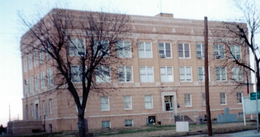Callahan County
Callahan County was created in 1858 from Bexar, Bosque and Travis Counties. The name of Callahan was selected in honor of James Hughes Callahan, a survivor of the Goliad Massacre and leader of the Callahan Expedition who died in 1856. The first white settlers, the Hart family, came into this area in 1863 and by the spring of 1877 there were enough settlers to request that the county be organized. The Commissioners Court of Eastland County granted permission and the first election of the county was held July 3, 1877. Callahan City was the first county seat of the county but after a heated campaign and controversy the town of Belle Plain became the county seat. After the arrival of the Texas & Pacific Railroad in the new town of Baird once again an election was held and in 1883 Baird became the county seat. Early Post Offices in Callahan County were: Shaw's Ranch, Callahan, Cross Plains, Deep Creek, East Caddo Peak, Caddo Peak, Belle Plain, Tomato, Annadale, Eagle Cove, Clyde, Rough Creek, Tecumseh, Hill, Cat Claw/ Putnam, Gould City/Vickery/Baird, Rowden, Oplin, Eula, Dressy, Atwell, Dudley, Land, Pueblo, Lander, Chatauqua, Toro, Cottonwood, Knob View, Admiral and Burnham. Early communities were: Admiral, Atwell, Baird, Bayou, Belle Plain, Cedar Bluff, Clyde, Cottonwood, Cross Plains, Denton Valley, Dudley, Eula, Midway, Oplin, Putnam, Rowden, and Tecumseh. Main towns in Callahan County are: Baird, Clyde, Cross Plains and Putnam with the communities of Eula, Cottonwood, Oplin, Denton Valley. Callahan County has had two colleges: The Belle Plain College started in 1881
Baird, in north central Callahan County, was established in 1880 with the building of the Texas & Pacific Railroad. Named for Matthew Baird, a director of the railroad, who drove the first stake on the Texas & Pacific survey in 1875, Baird housed a roundhouse, repair shops and switches that marked the railroad division point. In 1883 Baird became the county seat for Callahan County. The post office was named Baird when established on February 7, 1881, changed to Vickery in May of 1881 and renamed Baird in February 1883. The Texas & Pacific Railroad built an Immigrant House at Baird for families to stay while searching for the land they intended to settle. A fire almost destroyed the new town in 1883, but by 1884 several stores, a hotel and a restaurant were in operation. The town was incorporated in 1888. In 1889, in the western part of Baird, the Baird College was established, it was a two story wooden building. It is not remembered if the college burned or was torn down in the early 1900's. Population reached its peak in 1926 with 2,000. Today Baird remains a small town. Baird is located at the junction of Interstate 20 and U. S. Highway 283, 20 miles east of Abilene and 130 west of Ft. Worth.
